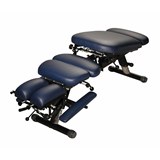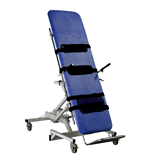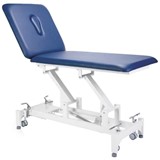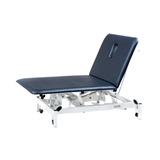When purchasing an examination table, it's essential to begin by setting a realistic budget that aligns with your medical practice's financial capabilities. Examination tables come in a wide range of prices, depending on their features and quality. Assess your practice's financial situation and determine the maximum amount you can allocate for this investment.
Remember that the examination table is a crucial piece of medical furniture that directly impacts both patient comfort and the efficiency of medical examinations. Allocating a reasonable budget will ensure that you can obtain a high-quality table that meets your practice's needs and provides a positive patient experience.
A. Balancing Cost with Quality
While budget constraints are important, it's equally vital to balance cost with the quality of the examination table. Opting for the cheapest option may lead to compromising on crucial features, comfort, and durability. On the other hand, the most expensive option may include features that exceed your practice's requirements.
To strike the right balance, thoroughly research different suppliers and models. Compare the features offered by various examination tables within your budget range. Look for key features that enhance patient comfort, support the needs of your medical practice, and comply with safety standards. A durable and well-designed table will offer better longevity and overall value for your investment.
B. Long-term Cost Savings
Consider the long-term cost savings associated with the examination table. While a higher-quality table might have a higher upfront cost, it can prove to be more cost-effective in the long run. High-quality materials and craftsmanship contribute to the table's longevity and reduce the frequency of replacements or repairs.
Additionally, investing in an examination table with ergonomic features can enhance the efficiency of medical exams, potentially reducing the time spent on each patient. A comfortable and easy-to-use table can contribute to higher patient throughput and increased overall productivity, benefiting your medical practice's bottom line.
Comparing Brands and Models of Examination Tables
When considering the purchase of an examination table, it is essential to compare different brands and models to make an informed decision. This section outlines the key steps to effectively compare examination table suppliers in a professional, informative, and objective manner.
A. Researching Reputable Suppliers
- Industry Experience: Begin by researching the industry experience of examination table suppliers. Established suppliers with a track record of serving the medical community are more likely to offer reliable products.
- Product Range: Explore the range of examination tables offered by each supplier. Look for suppliers that provide a variety of options, catering to different medical specialties and patient needs.
- Quality Standards: Assess the suppliers' commitment to quality standards. Look for certifications and compliance with relevant regulations, ensuring that the examination tables meet safety and performance requirements.
- Customer Feedback: Seek feedback from medical professionals and facilities that have previously purchased examination tables from the suppliers under consideration. Positive customer experiences can indicate a supplier's reliability.
B. Reading Customer Reviews and Testimonials
- Online Reviews: Look for independent reviews from verified purchasers of examination tables. Analyze both positive and negative feedback to gain a comprehensive understanding of the product's performance.
- Testimonials: Check the suppliers' websites or other reputable sources for testimonials from satisfied customers. These firsthand experiences can provide valuable insights into the supplier's reputation.
- Case Studies (if applicable): Some suppliers may present case studies of medical facilities that have implemented their examination tables successfully. Consider such studies for real-world usage scenarios and outcomes.
C. Evaluating Warranties and Customer Support
- Warranty Coverage: Examine the warranty details provided by each supplier. A comprehensive warranty indicates the supplier's confidence in the durability and reliability of their examination tables.
- Return Policy: Understand the return policy offered by the supplier in case of any issues with the examination table. A flexible and customer-friendly return policy can be an added advantage.
- Customer Support: Assess the quality of customer support offered by the supplier. Prompt and helpful customer service can be crucial if assistance is required during or after the purchase.
Addressing Regulatory and Compliance Standards in Medical Furniture
A. Understanding Relevant Regulatory Standards
When purchasing an examination table, it is crucial to be well-informed about the applicable regulatory standards governing medical furniture. Different regions or countries may have specific requirements that must be met to ensure patient safety and quality of care. Look for examination tables that adhere to the relevant medical device regulations and certifications.
- Research Local Regulations: Familiarize yourself with the medical furniture regulations in your region. These may include guidelines from health authorities or medical device regulatory bodies.
- Compliance with Medical Standards: Ensure that the examination tables meet the required safety and quality standards, such as ISO 13485 for medical devices.
B. Compliance with Infection Control Measures
In medical settings, infection control is of utmost importance. Examination tables should be designed to facilitate proper cleaning and disinfection to prevent the spread of infections. Consider the following factors when assessing the infection control capabilities of a table:
- Surface Materials: Opt for non-porous and easy-to-clean surface materials that can withstand regular disinfection without compromising durability.
- Seamless Design: Examination tables with seamless upholstery and minimal gaps reduce the risk of microbial growth and make cleaning more effective.
- Antibacterial Coatings: Some tables may come with antibacterial coatings, which can provide an additional layer of protection against harmful pathogens.
- Cleaning and Maintenance Instructions: Manufacturers should provide clear instructions on how to clean and maintain the examination table to ensure optimal infection control.
C. Certifications and Quality Assurance
To make a well-informed purchase decision, consider examination tables that come with relevant certifications and demonstrate a commitment to quality assurance.
- CE Marking: The CE mark indicates that the product complies with essential health and safety requirements within the European Economic Area.
- FDA Approval: If you are in the United States or other countries that recognize FDA approvals, consider examination tables that have received clearance or approval from the U.S. Food and Drug Administration.
- Manufacturer's Quality Control: Research the reputation and track record of the manufacturer. Look for companies with a history of producing reliable medical furniture and providing excellent customer support.
- Warranty and Service: Check the warranty offered by the manufacturer, as it can be an indicator of their confidence in the product's quality. Also, inquire about after-sales service and support options.
In conclusion, making informed decisions about the purchase of examination tables involves careful consideration of budget, quality, and regulatory standards. Setting a realistic budget ensures that your investment aligns with your practice's financial capacity, while balancing cost with quality ensures that you acquire a table that meets your needs and provides value over time. Long-term cost savings should be evaluated, as higher upfront costs for a durable table can lead to reduced expenses in the future. Comparing different brands and models allows you to choose a reputable supplier that offers quality products and reliable customer support.























